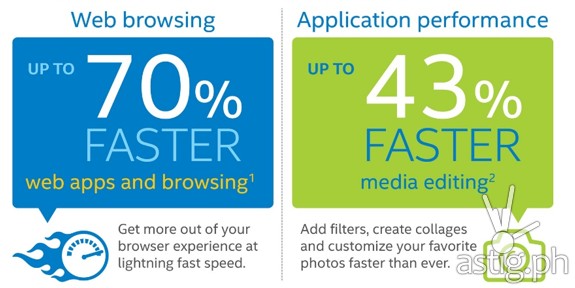More Is Always Best – Right? Wrong!
When buying a new tablet, performance is a key factor in your decision. From browsing the web, watching videos, playing games or getting connected with friends, performance is at the heart of your day to day experience.
It’s easy to assume that bigger numbers equal better performance, but sometimes numbers can be misleading. When it comes to the number of “cores” in a processor, fewer cores can be more efficient or powerful than more because it is not the number of cores that matter, but the quality of those cores. Plus, the more cores used, the more you have to make them work together efficiently.
So the belief that ‘more cores are better’ is not necessarily true, because not all cores are created equal.
Think of it like comparing an airplane with eight propellers to one with two jet engines. Would you fancy a long-haul flight on a plane with propellers?
App Check!Popular apps that use TWO cores or mostly TWO cores:
| Popular Apps | Core Utilization |
|---|---|
| Candy Crush | 2 cores |
| 2 cores | |
| Mostly 2 cores | |
| Minion Rush | Mostly 2 cores |
| Mostly 2 cores | |
| Modern Combat 4 | Mostly 2 cores |
Core Comparison: It’s Like Comparing Apples with Oranges
A core is the part of a processor that processes instructions for the computer. So every time you open an application such as a game or browser, or even type characters in a message, the instruction to perform any action is carried out by the core(s) in the processor.

“A core sucks in instructions and then processes them. It’s like a calculator, but having multiple calculators doesn’t help solve simple sums,” explains Christopher Kelly, head of Intel’s Malaysia Design Center, who helps design Intel’s chips. “More cores aren’t always better, because overall performance depends very much on how complex the sums are and how well designed the cores are to work together.”
When you have more cores, it’s a bit like having more musicians in a band – however when you have more musicians, it’s more challenging to ensure that they play in time and that they are all utilized to the right degree. This also involves changing all the sheet music to indicate which instrument is responsible for specific notes and how and when those notes should be played. “At Intel, we add more cores only when it makes sense and we spend considerable time and effort making sure that the hardware and software can work together to good effect,” adds Kelly.
If you look at the number of cores it takes to typically run apps such as Candy Crush* or Modern Combat 4*, TWO cores will be enough for them to run smoothly. This means that even with EIGHT cores or more, these apps won’t necessarily run faster, but may perform the same as they would with fewer cores. That’s like bringing an extra screwdriver when a spanner will do the job.
4-bit Or 32-bit?Processors built for 64 bit can process more numbers and sums than other common processors, which can use numbers just 32 bits long. So devices based on a 64-bit processor allows you to enjoy more processor-intensive apps like image and video editing, gaming, etc.
Not All Cores Are Built the Same Way
Intel’s processors are based on a 64-bit architecture, instead of a 32-bit one. That means a processor using a 64-bit process can compute more data than a 32-bit processor. It can calculate a bigger sum at the same time and if programmed correctly, makes it possible to manage more processes, which means improved performance. If you think of it like queuing at the supermarket, there are 64 checkouts instead of 32.
The impact of 64-bit can be seen if you compare our Intel® Atom® processor Z3480 on a like for like basis. “We tested the same applications using a native 64-bit setting versus a 32-bit setting,” said Kelly. “In doing so, the 64-bit setting gave better performance, making a chess simulator 34% faster, imaging 16% faster and data compression 33% faster. Put simply, 64-bit gives your device more power than 32 bit.”
Power When You Need It …
Another way to look at it is that as jet engines replaced propellers, airplanes needed fewer engines. Fast forward and look at the most modern airplanes in use today – such as the Airbus A330 and the Boeing 787 – and they use just two engines. Why? Because the jet engines have become more powerful and more efficient. If these planes had eight jet engines, they’d simply waste fuel.
Intel® Hyper-Threading Technology: This Intel technology allows the stream of instructions to be split up and processed simultaneously by different cores, so rather than waiting in a long line of people to pass through one door to enter a room, the line splits into multiple doors and enters the same room through multiple doorways. With this approach, it’s possible to utilize more cores to complete the task, but only switch on the cores you need when you need them, saving precious battery life
Just like jet engines, Intel’s cores have generally become more powerful over time and take less ‘gas’ for the same computation (i.e. power consumption). We also improve our chips’ multitasking ability, using a technique we call Intel® Hyper-Threading Technology. This means a processor can make better use of the cores it has and run more like a chip with more cores.
What about Graphics?
Graphic-intense PC gaming is one activity that can require more cores. Most popular games on the market today have been designed to use two or four cores, so you don’t necessarily need more cores to play cool games. In some cases, even if you buy an eight core processor, if the game wasn’t designed to use eight cores, it will likely only use the two or four cores it was designed to use.
“Adding more cores doesn’t necessarily bring you better gaming experience. It also depends on whether the software was written to optimize the potential of the processor to take full advantage of the computing power of more cores,” explains Kelly.

How Do We Test Out Cores?
Intel’s internal research shows that consumers in India and Indonesia will pay a premium for improved performance such as better battery life, faster processing power, HD graphics and better connectivity.
Say you want to edit pictures on the web and tag your friends, we found that it can actually be faster on some devices using the Intel® Atom™ processors which only have two cores – when compared to a device using another brand’s chip with four cores (see examples in this article of the ASUS MeMO Pad FHD 10, and Acer Iconia A1-830).

“Like an automatic gearbox changes gears in your car to adapt to the power needed at any given time, our processors can switch focus depending on whether to optimize for power or energy efficiency,” explains Kelly. “Not every processor has this kind of useful feature.”
Power consumption or battery life are also an important consideration because generally, the more cores, the higher the power consumption. Intel products optimize between these factors to give great performance together with power efficiency.
In Summary …
All things considered, comparing a tablet based on the number of cores is misleading, because not all cores are created equal.
Look at the overall performance you want and what you plan to use your tablet for, but don’t get caught by the core count myth!


